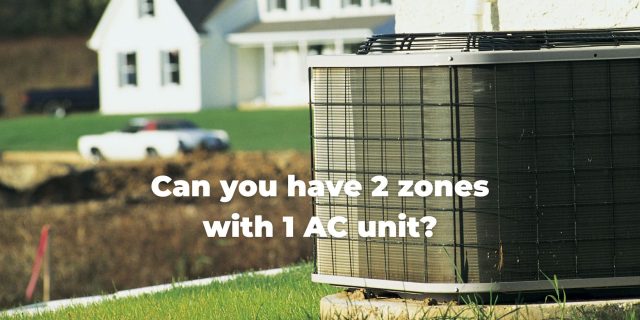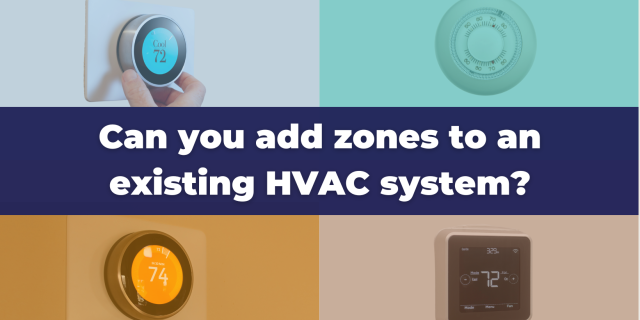
The Best Ductless Mini-Split Alternative: HVAC Zoning

Ductless mini-splits have gotten attention for their ability to address uneven temperatures in different rooms. But these units might not be the most efficient and convenient solution. Before you invest, consider a ductless mini-split alternative: HVAC zoning.
The Drawbacks of Ductless Mini-Splits
Ductless mini-splits offer several advantages, but they are not without their challenges. One significant drawback is the need for regular cleaning to ensure efficient operation. The filters and coils of mini-splits can accumulate dust and debris, reducing their effectiveness and potentially affecting indoor air quality. Homeowners must be diligent about maintaining these units, which can be time-consuming and tedious.
Additionally, ductless mini-splits can be visually unappealing. They require several additions to your home. The refrigerant lines required for these systems run along the exterior walls of your home. This can detract from your property’s aesthetic appeal. This might be particularly concerning for homeowners who take pride in their home’s exterior appearance.
Another issue is the necessity of managing an entirely separate piece of equipment. Ductless mini-splits function independently of your existing furnace, air conditioner, or heat pump. This adds another layer of complexity to your HVAC system, requiring additional attention and maintenance. Homeowners may find it cumbersome to juggle multiple HVAC units.
With these drawbacks in mind, you might want to consider other options as you make your home upgrade decisions. Consider this ductless mini-split alternative: HVAC zoning.
What Is HVAC Zoning?
HVAC zoning optimizes your home’s comfort by dividing your existing HVAC setup into multiple zones, each controlled by its own thermostat. Unlike ductless mini-splits, which require new units and separate maintenance, zoning utilizes your current furnace, air conditioner, or heat pump to direct airflow precisely where it’s needed. By installing dampers within the ductwork, your contractor will make it possible to regulate the distribution of hot or cold air. The dampers will enable different areas of your home to maintain independent temperatures. This targeted approach ensures that each room receives the perfect amount of heating or cooling based on its unique needs.
HVAC zoning provides a streamlined and efficient way to manage your home’s climate without adding more equipment. This method also helps in reducing energy consumption, as it eliminates the need to heat or cool unused spaces. By maximizing the efficiency of your existing HVAC system, zoning not only enhances comfort but also contributes to potential savings on energy bills.
Moreover, zoning installation is straightforward and minimally invasive. It doesn’t require anything noticeable to change in your home. Your new equipment will be hidden in the same utility area where your furnace or air conditioner is. It takes about a day, so your daily routine is not significantly disrupted. HVAC zoning offers better home comfort with minimal hassle, making it a great ductless mini-split alternative.
Why HVAC Zoning is the Best Ductless Mini-Split Alternative
One of the standout features of Arzel Zoning systems is their maintenance-free design. Unlike ductless mini-splits, which require regular cleaning and upkeep, our zoning systems need no ongoing maintenance, so you can enjoy hassle-free comfort.
Arzel Zoning systems also feature a lifetime warranty, offering peace of mind and long-term reliability. This warranty provides a significant advantage over ductless mini-splits, which typically do not offer such extensive coverage.
HVAC zoning also promotes energy efficiency. Since you can heat or cool specific areas of your home as needed, you avoid wasting energy on unused spaces. This targeted approach can lead to significant savings on energy bills.
Furthermore, the installation process is minimally invasive and can often be completed within a single day. There’s no need for extensive piping or external modifications, preserving your home’s aesthetic appeal.
Quick and Easy Installation of Zoning Systems
Installing an HVAC zoning system is a hassle-free process. After a quick one-day process, you’ll be back to your normal daily activities. Unlike ductless mini-splits, zoning systems do not require extensive external modifications or unsightly piping along your home’s exterior walls. Instead, dampers are installed inside your existing ductwork. These dampers direct airflow to designated areas without affecting your home’s appearance. The installation is carried out seamlessly, integrating with your current HVAC setup to provide immediate, efficient climate control. This streamlined approach makes HVAC zoning an attractive option for those looking to enhance home comfort quickly and without major inconveniences. Learn more about the installation process in our Answerbook.
Longevity and Compatibility with Future HVAC Equipment
Our HVAC zoning systems are engineered with longevity and adaptability in mind. They remain effective as your HVAC needs evolve. Unlike ductless mini-splits that will need to be replaced one day along with your other heating and cooling equipment, zoning systems are built to integrate seamlessly with future equipment upgrades or replacements. This compatibility ensures that your zoning system will continue to operate efficiently, even as you install a new furnace, air conditioner, or heat pump over the years.
One of the key benefits of HVAC zoning is its ability to adapt to the latest technology and innovations in HVAC systems. As newer, more energy-efficient models become available, your Arzel Zoning system will still be able to direct airflow precisely where it’s needed, maintaining optimal comfort in every room. This forward-thinking design minimizes the need for costly adjustments or replacements down the line, making it a wise long-term investment.
Moreover, the durability of Arzel’s HVAC zoning systems adds to their appeal. With minimal moving parts and robust construction, these systems are built to last, providing reliable performance for many years. This durability, coupled with the ability to adapt to new HVAC equipment, means homeowners can enjoy consistent, comfortable temperatures without the hassle of frequent maintenance or upgrades. By now you are probably seeing how HVAC zoning is a great ductless mini-split alternative.
Additionally, HVAC zoning systems from Arzel Zoning come with a lifetime warranty, offering extra peace of mind. This extensive coverage stands in contrast to the shorter-term warranties typically offered by ductless mini-split manufacturers. The lifetime warranty underscores the reliability and long-term value of zoning systems, ensuring that homeowners can trust in their performance and compatibility for years to come.
Conclusion: Why HVAC Zoning is the Superior Choice
For those seeking an efficient and reliable way to manage home comfort, HVAC zoning stands out as a superior choice. It utilizes your existing heating and cooling equipment, offering a streamlined approach that avoids the need for additional units and extensive maintenance. The installation process is quick and minimally invasive, allowing for immediate benefits without significant disruptions to your daily routine. With zoning, you can target specific areas of your home, ensuring each room receives the precise amount of heating or cooling it needs. This can lead to significant energy savings over time.
Unlike ductless mini-splits, zoning systems do not compromise your home’s exterior appearance with unsightly piping. If you choose Arzel Zoning, you also get the added peace of mind provided by a lifetime warranty. This long-term reliability and ease of use make HVAC zoning an attractive option for maintaining consistent indoor comfort. Additionally, the system’s compatibility with future HVAC upgrades ensures that your investment remains valuable as you update your heating and cooling equipment over the years.
In summary, HVAC zoning offers a less invasive, more efficient, and low-maintenance solution for optimal home comfort. Before deciding on a ductless mini-split, it’s worth considering the numerous advantages that HVAC zoning brings to the table. It’s the ductless mini-split alternative.
Topics
- Energy Efficiency (17)
- Homeowner Tips (19)
- HVAC Zoning (25)
- Indoor Air Quality (2)
- Indoor Comfort (32)
- Uneven Temperatures (5)
Recent Posts
View AllEverybody needs to heat and cool their home, and no one likes to pay for it. Even so, most of us are wasting energy to make our homes comfortable. This guide to HVAC zoning will show you how to avoid this pitfall. At the same time, you’ll get better comfort in your home. Imagine lower […]
Creating Multiple Comfort Zones with One AC Unit Can you have two zones with one AC unit? The answer is a resounding yes. With HVAC zoning, you can transform your home into multiple comfort zones, each tailored to your preferences. Instead of relying on a single thermostat to control the entire house, HVAC zoning uses […]
If you’re like most homeowners, you probably look for ways to save money on energy costs. Does HVAC zoning save money? We’ll explore that question here, so you’ll know what to expect if you decide to install HVAC zoning in your home. What Is HVAC Zoning? Let’s start with the basics. When you add zoning […]
Why many homes are uncomfortable Before we ask, “Can you add zones to your existing HVAC system?” it’s helpful to ask why you’d want to do that. Well, without adding zones, you’re left with just one temperature zone for the entire home. There are several issues with this. One thermostat doesn’t give you much control […]



